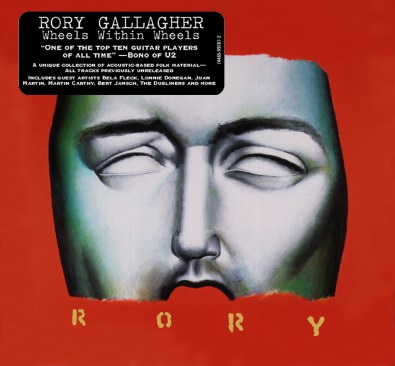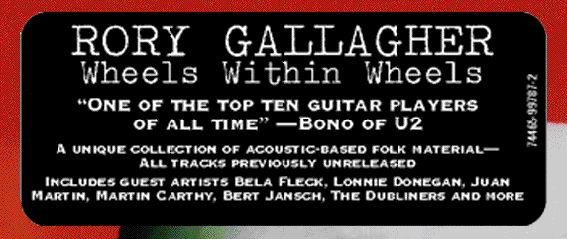| Wheels Within Wheels |
Wheels Within Wheels...
... is the title of the new album by the much-missed Irish hero of blues-rock guitar legend. Not only does it represent the realisation of a long-held dream of Rory's to release a record of acoustic folk flavours, it also bathes his musical legacy in an elegant new light. The album follows a recent emphatic endorsement of Gallagher's cultural standing, when the Irish Postal Service included him on a set of four music stamps along with U2, Van Morrison and Phil Lynott. Longtime Rory Gallagher fans always loved the acoustic sets with which he would regularly season his hard-driving blues and rock performances. His untimely death in June 1995 left his ambition to make an album of such material unfulfilled, but not any more. Keenly in tune with his brother's tastes in acoustic music, Donal Gallagher has crafted long at this labour of love, working with material spanning some 25 years of Rory's four-decade career. Wheels Within Wheels is the remarkable result.

CD catalogue number : CAPO 703

Tracklist
Comments by Donal Gallagher
Wheels Within Wheels (1978)
"That's likely to be the single, recorded in San Francisco and finished off
in Germany. He'd completed an album in San Francisco and binned it. That
particular track he never went back to it, and I felt it was a beautiful
track."
Flight To Paradise (1984)
"That was done during a period where Rory was out on what was called the
Guitarists' Night, which was David Lindley, Richard Thompson, Juan Martin
and Rory. This is a number that Rory started doing on stage with Juan, what
they would do was mix and match the four guitarists. That was recorded in
London."
As The Crow Flies (1974)
"I hadn't intended to use that, we were finishing off the album in France,
and one day I got a call from BMG France. There was a French movie being
finished off and they wanted to use As The Crow Flies. I said fine, and I
put the phone down and found this multi-track sitting in front of me. It was
the studio version. I rang them back and said I'll do a new version. The
film was set in the 17th century, it's called Blanche, it's been No.1 in the
French box office. It stars Gerard Depardieu and Antoine de Caunes, a big
cast, and it gets released in March here."
Lonesome Highway (1975)
"It's electric really, but I felt it was a suitable candidate for the album,
it had that feel, there was lots of soft guitar, and I knew Rory was adamant
that when he would make this album it wouldn't bar electric, for colouring
and stuff. We had 22 boxes of a track called It's Only Raining, we were down
to the wire and having to take verses and build a song. It got to 2 in the
morning, I said I've got to go to bed, I walked out the door and spotted
this other box that said Lonesome Blues. The engineer woke me up at 4 in the
morning and said it's the complete track. There were two titles to it."
Bratacha Dubha (1994)
"He adored Martin Carthy, they'd met down through the years, paths crossed
and they played gigs together. And Martin was passionate about Rory, they
had all sorts of great plans and they were going to do all sorts of folk
ideas. Maire Ni Chathasaigh, who's on the track with Martin, she's
traditional musician of the year in Ireland, she's amazing. I included her
because that was probably one of the last gigs Rory would have gone to, at
the Troubadour, he'd go there regularly to see Maire and Chris Newman, her
husband, playing together. She played at Rory's memorial. That piece of
music was one of the last things Rory wrote, it's almost like
Irish-Elizabethan music."
She Moved Thro? The Fair/Ann Cran Ull (1993)
"Rory was extremely fond of Bert Jansch. My encounter with Bert Jansch, a
year after Rory died, was speaking to him about his catalogue, and the book
Dazzling Stranger that had come out about Bert. Out of the blue he just
mentioned, did you hear the track Rory and I were going to do together?
That's how that turned up."
Barley & Grape Rag (1993)
"That was done here in London, the Dubliners had put out their own version
of it, but this was the way I felt Rory wanted the track to be, which was
more warts and all and having a laugh in the studio."
The Cuckoo and Deep Elm Blues (1977-78)
"Roland van Campenhout is a doyen of continental folk, he lives in Belgium
and we went over and lived there for a year, we had a studio at the end of
his garden. He had housed a lot of the American folk musicians who come into
Europe, like Ramblin Jack Elliott. Again these were mono tapes, so I brought
Roland back in, he just coloured a little to get the stereo dimension. One
of them's a jam from the Ghent Festival."
Amazing Grace, Walkin' Blues and Blue Moon of Kentucky (1994)
"Done in 1994 at Montreux Jazz Festival. I don't think Bela and Rory had met
before that encounter. Bob Dylan was on the bill, and he had planned to
cover a track Rory had done on Live In Europe [1972] called I Could've Had
Religion, which was one of Dylan's favourites. He'd asked Rory to play it
that night, Dylan had decided to open the show and then Rory was on later.
It had been a possibility that Dylan would come on, so Rory sort of
indicated to the side and actually it was Bela Fleck that walked on with a
banjo! The intro of Amazing Grace is a bit like Duelling Banjos, it's like
them finding their pitch, then it warms up and gets into Walkin' Blues. Then
the confidence was there. I've never heard Rory do Blue Moon of Kentucky in
my life, that night he just went into it, he was obviously loving it so
much. That was absolutely impromptu, they'd never even tuned up together.
Rory was doing Walkin' Blues since the early Taste days."
Goin' To My Hometown (1980)
"That was a track I took to Lonnie back in 1976, I felt it was Rory's homage
to skiffle in a way, and Lonnie was always planning to do it. I was good
friends with Lonnie, in fact on the Capo label we put out the Muleskinner
Blues album, which was the forerunner to the Skiffle Sessions, it had the
two Van Morrison tracks and again it was using Rory's label as a sort of
homage to his heroes."
Lonesome Highway Refraining (1975)
"There were two different endings to Lonesome Highway. One was optimistic
| and one was pessimistic. We made it ambiguous." |